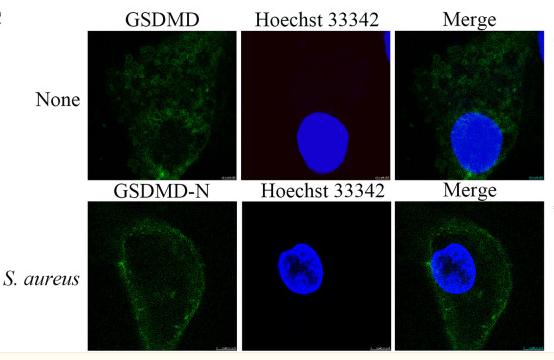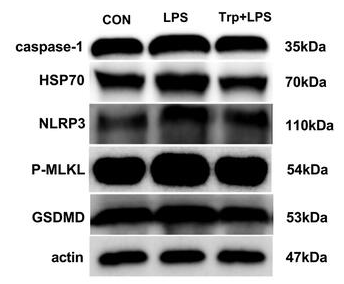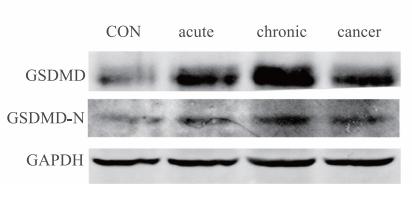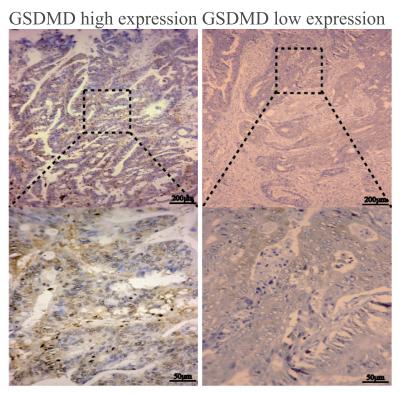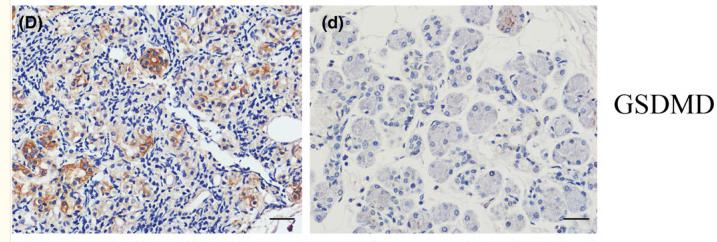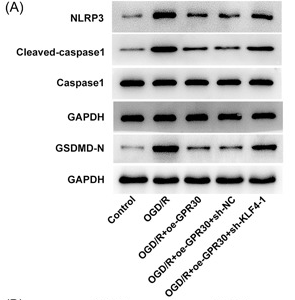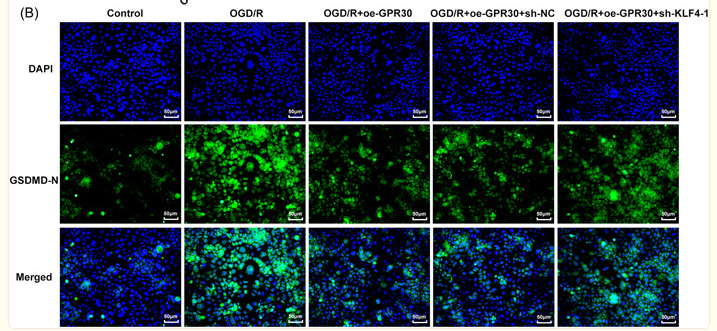GSDMD Antibody - #DF12275
| Product: | GSDMD Antibody |
| Catalog: | DF12275 |
| Description: | Rabbit polyclonal antibody to GSDMD |
| Application: | WB IHC IF/ICC |
| Reactivity: | Human |
| Prediction: | Pig, Bovine, Horse, Dog |
| Mol.Wt.: | 50kDa; 53kD(Calculated). |
| Uniprot: | P57764 |
| RRID: | AB_2845080 |
Related Downloads
Protocols
Product Info
*The optimal dilutions should be determined by the end user.
*Tips:
WB: For western blot detection of denatured protein samples. IHC: For immunohistochemical detection of paraffin sections (IHC-p) or frozen sections (IHC-f) of tissue samples. IF/ICC: For immunofluorescence detection of cell samples. ELISA(peptide): For ELISA detection of antigenic peptide.
Cite Format: Affinity Biosciences Cat# DF12275, RRID:AB_2845080.
Fold/Unfold
1810036L03Rik; DF 5L; DF5L; DFNA 5L; DFNA5L; FKSG 10; FKSG10; FLJ12150; Gasdermin D; Gasdermin domain containing 1; Gasdermin domain containing protein 1; Gasdermin domain-containing protein 1; Gasdermin-D; GasderminD; GSDMD; GSDMD_HUMAN; GSDMDC 1; GSDMDC1;
Immunogens
Expressed in the suprabasal cells of esophagus, as well as in the isthmus/neck, pit, and gland of the stomach, suggesting preferential expression in differentiating cells.
- P57764 GSDMD_HUMAN:
- Protein BLAST With
- NCBI/
- ExPASy/
- Uniprot
MGSAFERVVRRVVQELDHGGEFIPVTSLQSSTGFQPYCLVVRKPSSSWFWKPRYKCVNLSIKDILEPDAAEPDVQRGRSFHFYDAMDGQIQGSVELAAPGQAKIAGGAAVSDSSSTSMNVYSLSVDPNTWQTLLHERHLRQPEHKVLQQLRSRGDNVYVVTEVLQTQKEVEVTRTHKREGSGRFSLPGATCLQGEGQGHLSQKKTVTIPSGSTLAFRVAQLVIDSDLDVLLFPDKKQRTFQPPATGHKRSTSEGAWPQLPSGLSMMRCLHNFLTDGVPAEGAFTEDFQGLRAEVETISKELELLDRELCQLLLEGLEGVLRDQLALRALEEALEQGQSLGPVEPLDGPAGAVLECLVLSSGMLVPELAIPVVYLLGALTMLSETQHKLLAEALESQTLLGPLELVGSLLEQSAPWQERSTMSLPPGLLGNSWGEGAPAWVLLDECGLELGEDTPHVCWEPQAQGRMCALYASLALLSGLSQEPH
Predictions
Score>80(red) has high confidence and is suggested to be used for WB detection. *The prediction model is mainly based on the alignment of immunogen sequences, the results are for reference only, not as the basis of quality assurance.
High(score>80) Medium(80>score>50) Low(score<50) No confidence
PTMs - P57764 As Substrate
| Site | PTM Type | Enzyme | Source |
|---|---|---|---|
| Y37 | Phosphorylation | Uniprot | |
| K43 | Ubiquitination | Uniprot | |
| K51 | Ubiquitination | Uniprot | |
| K55 | Ubiquitination | Uniprot | |
| K62 | Ubiquitination | Uniprot | |
| S79 | Phosphorylation | Uniprot | |
| K145 | Ubiquitination | Uniprot | |
| S152 | Phosphorylation | Uniprot | |
| Y158 | Phosphorylation | Uniprot | |
| T161 | Phosphorylation | Uniprot | |
| K168 | Ubiquitination | Uniprot | |
| S181 | Phosphorylation | Uniprot | |
| S185 | Phosphorylation | Uniprot | |
| S201 | Phosphorylation | Uniprot | |
| K203 | Ubiquitination | Uniprot | |
| K204 | Ubiquitination | Uniprot | |
| K236 | Ubiquitination | Uniprot | |
| K248 | Ubiquitination | Uniprot | |
| S250 | Phosphorylation | Uniprot | |
| T251 | Phosphorylation | Uniprot | |
| S252 | Phosphorylation | Uniprot | |
| S261 | Phosphorylation | Uniprot | |
| K299 | Ubiquitination | Uniprot |
Research Backgrounds
Promotes pyroptosis in response to microbial infection and danger signals. Produced by the cleavage of gasdermin-D by inflammatory caspases CASP1 or CASP4 in response to canonical, as well as non-canonical (such as cytosolic LPS) inflammasome activators. After cleavage, moves to the plasma membrane where it strongly binds to inner leaflet lipids, including monophosphorylated phosphatidylinositols, such as phosphatidylinositol 4-phosphate, bisphosphorylated phosphatidylinositols, such as phosphatidylinositol (4,5)-bisphosphate, as well as phosphatidylinositol (3,4,5)-bisphosphate, and more weakly to phosphatidic acid and phosphatidylserine. Homooligomerizes within the membrane and forms pores of 10 - 15 nanometers (nm) of inner diameter, possibly allowing the release of mature IL1B and triggering pyroptosis. Exhibits bactericidal activity. Gasdermin-D, N-terminal released from pyroptotic cells into the extracellular milieu rapidly binds to and kills both Gram-negative and Gram-positive bacteria, without harming neighboring mammalian cells, as it does not disrupt the plasma membrane from the outside due to lipid-binding specificity. Under cell culture conditions, also active against intracellular bacteria, such as Listeria monocytogenes (By similarity). Strongly binds to bacterial and mitochondrial lipids, including cardiolipin. Does not bind to unphosphorylated phosphatidylinositol, phosphatidylethanolamine nor phosphatidylcholine.
Cleavage at Asp-275 by CASP1 (mature and uncleaved precursor forms) or CASP4 relieves autoinhibition and is sufficient to initiate pyroptosis. Cleavage at Asp-87 by CASP3.
Cytoplasm>Cytosol. Inflammasome.
Note: In response to a canonical inflammasome stimulus, such as nigericin, recruited to NLRP3 inflammasone with similar kinetics to that of uncleaved CASP1 precursor.
Cell membrane. Secreted.
Note: Released in the extracellular milieu following pyroptosis.
Expressed in the suprabasal cells of esophagus, as well as in the isthmus/neck, pit, and gland of the stomach, suggesting preferential expression in differentiating cells.
In response to a canonical inflammasome stimulus, such as nigericin, recruited to NLRP3 inflammasone with similar kinetics to that of uncleaved CASP1 precursor. Although this recruitment is also observed in the absence of PYCARD, it is more efficient in its presence (By similarity). Gasdermin-D, N-terminal forms disulfide-linked homooligomers (16-mers) in a Ca(+2)-independent manner. Oligomerization occurs in the presence of membranes; cytosolic Gasdermin-D, N-terminal remains monomeric.
Intramolecular interactions between N- and C-terminal domains may be important for autoinhibition in the absence of cleavage by inflammatory caspases CASP1 or CASP4. The intrinsic pyroptosis-inducing activity is carried by gasdermin-D, N-terminal, that is released upon cleavage by inflammatory caspases.
Belongs to the gasdermin family.
Research Fields
· Organismal Systems > Immune system > NOD-like receptor signaling pathway. (View pathway)
References
Application: WB Species: bovine Sample: MAC-T cells
Application: IF/ICC Species: bovine Sample: MAC-T cells
Application: WB Species: pig Sample:
Application: WB Species: piglets Sample: liver
Application: IHC Species: Human Sample: HK-2 cells
Application: WB Species: Human Sample: HK-2 cells
Application: WB Species: mouse Sample: colonials
Application: IHC Species: human Sample: colorectal cancer tissues
Application: IHC Species: Human Sample: IgG4‐RS tissues
Application: WB Species: Human Sample: Caco‐2 cells.
Application: IF/ICC Species: Human Sample: Caco‐2 cells.
Restrictive clause
Affinity Biosciences tests all products strictly. Citations are provided as a resource for additional applications that have not been validated by Affinity Biosciences. Please choose the appropriate format for each application and consult Materials and Methods sections for additional details about the use of any product in these publications.
For Research Use Only.
Not for use in diagnostic or therapeutic procedures. Not for resale. Not for distribution without written consent. Affinity Biosciences will not be held responsible for patent infringement or other violations that may occur with the use of our products. Affinity Biosciences, Affinity Biosciences Logo and all other trademarks are the property of Affinity Biosciences LTD.


